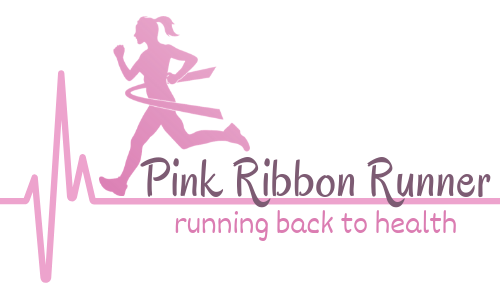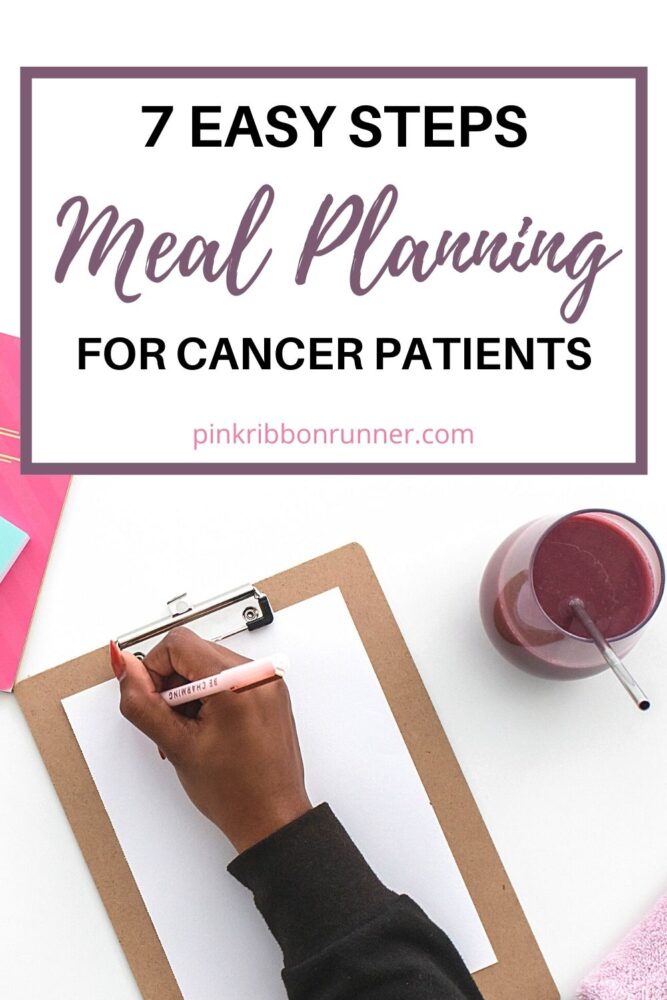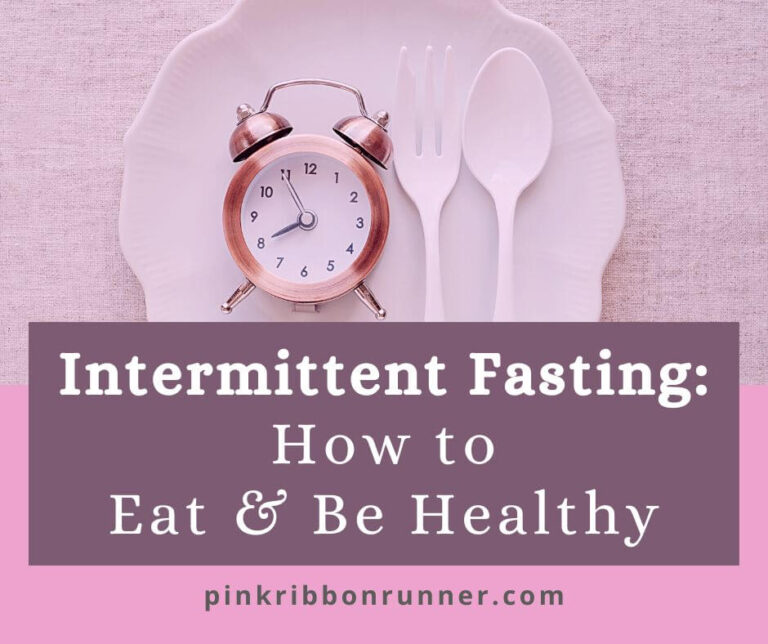7 Easy Steps to Meal Planning For Cancer Patients
Meal planning is a healthier, cheaper and easier way to eat. Cancer patients can use this efficient tool to help schedule weekly meals around their treatments. Chemotherapy, radiation, and surgery can render meal making a difficult chore. This article explains how menu planning and meal preparation can make the life of a cancer patient easier in 7 simple steps.
This post contains affiliate links. As an Amazon Associate, I earn from qualifying purchases.
I will be completely honest with you. I am not an expert at meal planning. Actually, I don’t even like to meal plan. In fact, I dread it. But I do know that there are many benefits of taking the time to plan out weekly meals. And, I do know how to do it.
When you have been diagnosed with cancer, and face going through treatments, meal planning can keep you eating healthy meals during this horrendous time. And meal planning around your cancer treatments is something I, unfortunately, have some experience with.
Benefits of Meal Planning
If you search the internet for meal planning you will come across a plethora of articles telling you all about the benefits of meal planning. I won’t go into too much detail here. However, I do want to tell you that all those benefits are true.
- When you plan out your meals in advance, you simply eat healthier meals
- Preparing meals in advance saves time
- Planning out meals saves money
- Portioning out individual meals will control calories and help you achieve and maintain a healthy weight
- You feel better when you don’t overeat and when you eat healthy foods
- You don’t have to think about what to make, making mealtime less stressful
- There is less food waste when you plan meals
- You are less likely to grab quick, convenience food that is less healthy
Additional Benefits of Meal Planning for Cancer Patients
What isn’t talked about much, is meal planning for cancer patients. So, let me tell you some of the additional benefits I found when going through my treatments.
- Preparing meals in advance of chemo means you have food ready to go when you are too tired or nauseated to cook.
- After surgery, you may have physical limitations that make cooking impossible or unsafe. Having pre-made meals to fall back on are so helpful.
- Radiation makes you very tired. Making dinner after a treatment can be a real chore. Having healthy freezer meals that you can just throw in the oven or instant pot is such a relief.
- Planning for your nutritional needs, like adding in healthy proteins and cancer-fighting vegetables, allows you to recover from treatments faster.
- And having ready-to-go meals makes it easier for family and friends to help you out. They can prepare a meal or two by simply reheating or cooking ready-chopped ingredients.
What Tools Do You Need for Healthy Meal Planning?
You can certainly do meal planning on the computer. There are apps and websites that can help you. But I much prefer to do my planning on good old-fashioned paper. I find it easy to take the menu shopping or post it on my fridge for all the family to see.
I use 6 tools for my menu planning.
1. Calendar of Events
You will want to plan meals around your treatments, activities, or even special occasions. So have your calendar handy so you can see what the week has scheduled for you.
2. Pen or Pencil
If you are planning out meals on paper, you will need some pens and pencils, of course. I also like to use highlighters and colorful markers to emphasize important bits. For example: Writing the macros, such as proteins, fats and fiber, in different colors makes planning a bit easier and more fun.
3. Meal Planner Template
It is so much easier to plan out meals when you have a printable template. This can be as simple as a sheet of paper with breakfast, lunch and dinner headings.
Some people like to keep a menu board in their kitchen. I have seen many beautiful examples of menu chalkboards.
4. Blank Grocery List
You will want to list all the items you need to purchase for preparing your weekly meals, so a grocery list template is helpful.
Some even keep a grocery checklist with all the essential staples or commonly purchased items. This makes it easy to check your freezer or pantry to see what you already have and what you need to buy.
5. Delicious Recipes
Grab those home recipes to browse through for some delicious ideas for meals. This helps prevent the monotony of preparing and eating the same meals week after week.
6. Grocery Flyers
It helps to plan around sales of the week too. There is no sense in paying full price for chicken, for example, when turkey breast is on sale. So look for good deals when planning out your meals for the week.
Meal Prep Considerations for Cancer Patients
Hopefully your oncologist or surgeon has given you some idea about what your recovery will be like. Sometimes you may experience weakness or limited range of motion that makes preparing and cooking meals difficult. You may not have grip strength to open jars, for example. Or perhaps you can’t reach up onto the top shelf of the cupboard. Planning ahead can help you know what you need to have handy.
Here are some items that may help make preparing and cooking meals a little easier:
- Mandolin
- Food Processor
- Stand Mixer
- Electric Knife
- Electric Can Opener
- Ergonomic Knife
- Ergonomic Cooking Utensils
- Grabber Tool
- Lighter Weight Cookware
- Food Chopper
- Electric Jar Opener
- Food Saver
Food Containers for Storing Healthy Meals
I have concerns about heating food up in plastic dishes. I know that many of these containers may be microwave, or even oven safe. But I also know that there are many scientific studies that tell us that food heated in plastic may not be safe.
Some plastics contain toxic chemicals, such as BPA and phthalates, that are released into food, especially during heating. Some plastics may be safe. But, as a cancer survivor, I don’t want to take this chance when there are alternatives. I much prefer using oven-safe glass containers.

7 Easy Steps in Meal Planning for Cancer Patients
Because I don’t really like to meal plan, I try to make it as easy and painless as possible. I have come up with a system that works best for me. I will share that with you now in 7 easy steps.
Step 1: Planning Your Menu
First, have a quick look through your pantry, fridge, and freezer. Take note of what you already have. Developing a regular checklist for this is helpful.
Then, get to work on planning out your meals. Make yourself a cup of tea, grab your meal planning tools and get comfortable. Pick a day when you have more time and can think and focus on the task at hand. It’s always best to be consistent and develop this into a routine, so pick a day of the week that is most convenient. For me, this is on a quiet Saturday morning.
Next, cross off any days that week you know you won’t be cooking. This may be on the day of chemotherapy when you know you will be too nauseated to eat. Or, perhaps you need to fast for surgery or a medical test. It may simply be a date night, where you know you will be going out to a restaurant.
Plan Dinners First
The next step is to plan for dinners. Pick a protein first, then add on sides of vegetables and fiber to balance it. Protein is one of the most important components of the meal and one that is hardest to ensure is healthy and adequate.
Then plan lunches, followed by breakfasts, each time starting with the protein and working around it. Breakfasts are usually the easiest to plan, as we tend to be fairly consistent with our breakfast choices from day to day.
Keep meals simple
Don’t over complicate your meals. An oven-roasted chicken is much easier to cook than chicken cordon blue, for example. Save the complicated recipes for a special occasion. Every day meals should be simple and clean.
Plan For Snacks
Don’t forget to plan out some healthy snacks too. Planning for snacks prevents impulse snacking of unhealthy foods and unwanted calories.
In fact, sometimes it is better to plan for about 6 smaller meals, instead of 3 larger meals. It is simply easier to cook a small meal than it is to cook a big full-course meal.
More daily meals also allow you to skip one if you aren’t up to cooking or eating that day, after a chemo treatment for example. If you miss 1 of 3 meals, you may not get all your essential nutrition. But if you miss only 1 of 6 meals, you are more likely to get enough protein and veggies into your day.
Step 2: Inventory of Items on Hand
After you have all your meals planned out, grab your grocery list and food inventory checklist. Go through your pantry, fridge and freezer again to see what you need to buy for the meals you have planned out.
Organize your grocery list by the isles in the store. You may want to include categories such as deli, dairy, bakery, meats, fresh produce, canned or boxed items.
Step 3: Shopping for Groceries
Now it is time to go shopping. Don’t forget your list. I am notorious for forgetting my lists at home. Don’t be like me.
Grab a pen or highlighter to mark off items you have placed in your cart. This makes shopping that much more efficient and faster.
You may also need your coupons, flyers and re-usable bags.
Another thing I am notoriously bad at doing is JUST FOLLOWING THE LIST. Trust that you have planned everything out well. Stick to your list and avoid impulse buying.
The urge to buy junk food is highest when we are hungry. So eat a snack before grocery shopping, or go after a meal.
Shopping during cancer treatments
If you can ask someone to do your shopping for you, do it. People want to feel helpful, especially when a friend is going through cancer. Let them help you pick up a few things at the store.
If you are too tired to shop, try online shopping. There are many grocery stores that have an online ordering system. Then you simply pick up your items, or have them delivered. There is usually a small fee for this service. But in my opinion, it is well worth it. I found I was too exhausted to do all the shopping, load up the car, drive home, unload the car and then put it all away.
Again…
LET PEOPLE HELP YOU!
Step 4: Preparing the Ingredients
You may want to enlist the help of family or friends for the meal prep work too. It is a lot for one person. Share the work to ease your burden. Save your strength for cancer-fighting and healing.
Pick a day that you have more energy, before a test or treatment. Divide up the day into smaller more manageable chunks. Rest in between these chunks of preparation.
You can even do prep work on different days, such as washing and chopping veggies on Monday, cooking on Tuesday and packaging on Wednesday.
Be clean. Be safe.
Wash your hands well before preparing food. Food safety and cleanliness are especially important for cancer patients, as your immune system may not be able to fight off opportunistic bacteria that can contaminate food.
Avoid wooden cutting boards, as they can harbor germs. And disinfect your counter tops often, especially between batches of food preparation or after working with raw meats.
Step 5: Cooking Your Meals Ahead
Cook ingredients in batches. For example, you can cook all the rice for the week in one batch. Rice, quinoa, pasta, and potatoes all freeze well. If you are able, or if you have enlisted help, make extra.
Cook foods to recommended temperatures. Cancer patients can have compromised immunity, so avoid raw or undercooked foods during chemotherapy. Food safety guidelines suggest to cook poultry and meats to an internal temperature of 165 oF (74 oC).
Step 6: Packaging and Storing Your Meals
Food safety extends to storing foods too. Don’t leave food sitting out on the kitchen counter too long. Cover cooked foods and refrigerate within 2 hours. Freeze your meals within 3 days of preparing, if they are just in the fridge.
There are a few ways you can store pre-made meals. I will list three ways here.
1. Individual Meals
Plating out individual meals for reheating later is likely one of the better ways for cancer patients. This makes thawing and reheating much easier, with less waste. Calories and nutrients can be divided out for better portion control when individual meals are made.

2. Make-Ahead Family Meals
Casseroles, soups and stews can be frozen in larger containers if you are making family meals. This saves time for plating out individual portions, although these take longer to thaw and reheat.

3. Prepared Ingredients to Cook Later
You can also prepare individual ingredients, freeze them and cook later. I like to do this with my stews. I will freeze the meats separate from the vegetables. Then I combine them in my instant pot or crockpot just prior to cooking.

Label Your Meals
Don’t forget to label your bags with what is inside and the date it was prepared. This makes it so much easier to find what you want. Many things can look similar when bagged and frozen. If you want teriyaki marinade chicken, then you don’t want to grab the pre-cooked stewing beef. I’ve done this and it can be very frustrating when you discover you have thawed out a wrong ingredient.
Step 7: Reheating and Eating Your Delicious Meals
Keep a menu for the week where you can see it. You will want to take any freezer meals out at least the night, if not a day or two, before.
Follow food safety guidelines for thawing meals. It is best practice to thaw any frozen foods in the fridge.
Always reheat your meals and casseroles to a temperature of 165 oF (74 oC) to ensure any potential bacteria are killed. You are more likely to get food poisoning if you are going through chemotherapy.
Healthy Pantry Meals Alternatives
If you don’t feel like eating the meal you have planned out for a particular day, it is nice to have a healthy alternative in the pantry. And trust me, there will be days you don’t want to eat from your planned menu.
Meals you make from stored items in your pantry can be quick and handy. However, eating fresh foods is always preferred. Fresh foods taste better and don’t contain the salts and preservatives that dried or canned goods may contain. Pantry meals should be the exception, rather than the rule. But they can make for a quick and delicious meal on those days you just need a light meal or comfort food.
Quick Pantry Meal Ideas for Cancer Patients
When stocking your pantry look for healthier or organic items that are lower in salt, fats and sugars. However, just eating what you have on hand, in a pinch, is okay as long as you don’t make it a habit. Once in a while, a quick meal made from the items in your pantry is perfectly fine. This is especially true on the days you just don’t feel up to making anything else.

Pantry Snack Ideas for Cancer Patients
Perhaps you don’t feel like an entire meal either? It is okay to skip a meal or two and just have a light snack. Cancer patients need to do what they can to get through treatments. And that may mean not eating for a day or two. Or it may mean grabbing a light snack from the cupboard.
Try to stock your pantry with healthier snack items to have on hand.

10 More Meal Planning Tips for Cancer Patients
And finally, I will leave you with 10 more tips for meal planning.
- Remember to keep it simple. Complicated only looks good on paper. You will tire easily if it is too complex or your meals are too fancy. Some examples of easier ways to cook include crockpot or instant pot cooking, casseroles, one-dish roasts and stews.
- Make what you like to eat. It is important for your meals to be enjoyable too. Find healthier versions of your favorite comfort foods and recipes.
- Shop in smaller grocery-only stores. Avoid big stores that sell more than just groceries. Smaller stores mean less walking, closer parking, and faster shopping. There is also less temptation to spend money on non-essential items.
- Stick to your shopping list. Avoid buying on impulse. These tend to be less healthier choices.
- Get the family onboard with eating from a menu. Enlist family members to help with planning. Each person can choose a favorite meal for one day of the week, for example. Ask them to help you with meal prep, including clean up. Put on some music. Make it fun.
- Learn more about meal planning and ways to make it simpler. There are some wonderful bloggers out there who are excellent resources on meal planning. And while they may not understand what it is like to recover from a cancer treatment, they do know how to prepare delicious and healthy meals.
- Consider theme nights if you are getting bored with menus and need fresh ideas. Some examples are fish taco Tuesday or cruciferous vegetable night.
- Keep your menu handy. Print and post it on your fridge. Use a menu board. This will keep you focused on healthy eating. It also helps you remember what you planned and when to take your meals out of the freezer.
- Have a back up plan for healthy eating on the days you don’t feel like eating from the menu or cooking. These could be pantry meals or snacks. Make a list of your favorite quick & healthy backup meals. But remember to make this the exception, not the rule.
- Ask for help. And if you need a meal service, like Meals-On-Wheels, ask your cancer care team for recommendations.
If you are looking for more information on healthy eating, check out these articles on Pink Ribbon Runner.
12 Foods to Avoid During Chemotherapy
Do’s & Don’ts of Eating During Cancer Radiation Therapy
10 Foods that Boost Your Immune System









Before I started chemo for the third time , I cooked extra at each
Meal so that I had food to
Put in individual containers in the freezer . My husband has frontal
Lobe dementia so it is difficult for him
To cook
A meal and he couldn’t help
Me with getting something for myself . I made sure I had soups , crackers , instant potatoes and other items that could be easily prepared . Also cooked extra pancakes and French toast for the freezer so breakfast was fairly easy and had cooked ham and bacon In the freezer for my husband . Bland foods is my diet during chemotherapy .
Sounds like you did very well with planning. I am sorry you have to deal with all that. But you have found some great ideas for dealing with your meals.
very helpful and realistic tips! meal prep/planning is not easy but once it became a routine and alloting time to plan ahead it can help save time and money. thank you for this
These are some amazing suggestions for someone with a loved one battling cancer! I will forsure pass this along!
Very informative. I will pass this along
Thanks, these are all great tips and suggestions for meal planning!
I love your blog — the name is cool and unique. I also like the way you structure your blog post, it’s so organized and neat. When you said you dreaded meal planning, I didn’t believe it at first because the way you talk about it, it’s like you love it! I also can’t stand the thought of meal planning. I mean having to think and nitpick which healthy food to eat sounds awful but I do understand the situation. Your blog post is very helpful for cancer patients and caretakers of them! God bless you.
Thank you for your praise. I know the value of meal planning and I do it. It is like any chore, it gets done. But I would rather go for a run or a hike. 😉
These tips are also perfect for the ones who have a family member with cancer! thanks for sharing